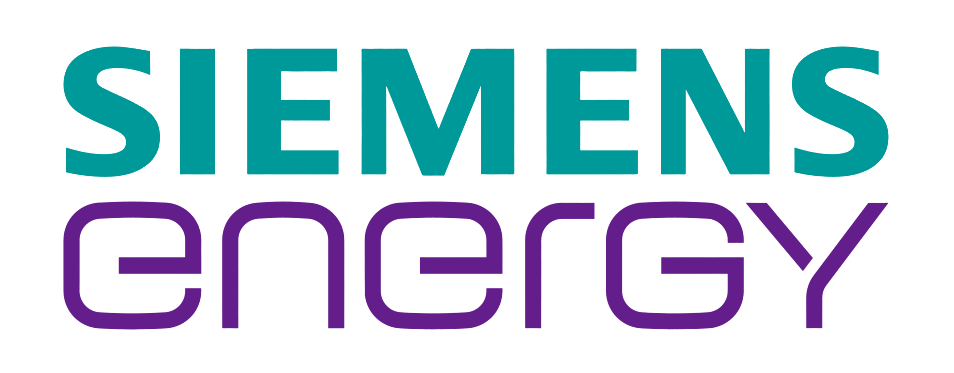As the penetration of inverter-based renewable energy (IBRE) resources continues to increase, the dynamics and control strategies of grids too have undergone significant advancements. Among these advancements, grid-forming inverters (GFI) have emerged as a groundbreaking technology with the potential to revolutionize the generation, distribution, and consumption of electricity. GFI technology finds widespread application in Battery Energy Storage System (BESS), wind power plants, solar PV plants, and hybrid plants, showcasing its versatility and effectiveness in optimizing energy systems and enhancing grid stability. While our understanding of GFI controls is still evolving, they hold tremendous promise for enhancing the performance of bulk power systems. With the rise of renewable energy sources and the growing complexity of power grids, traditional approaches to system operation face new challenges. GFIs are paving the way for the seamless integration of renewable energy, energy storage, and grid stability. In this article, we will delve into the transformative potential of GFIs and explore how they are reshaping the landscape of power systems, ushering in a new era of efficiency and adaptability.
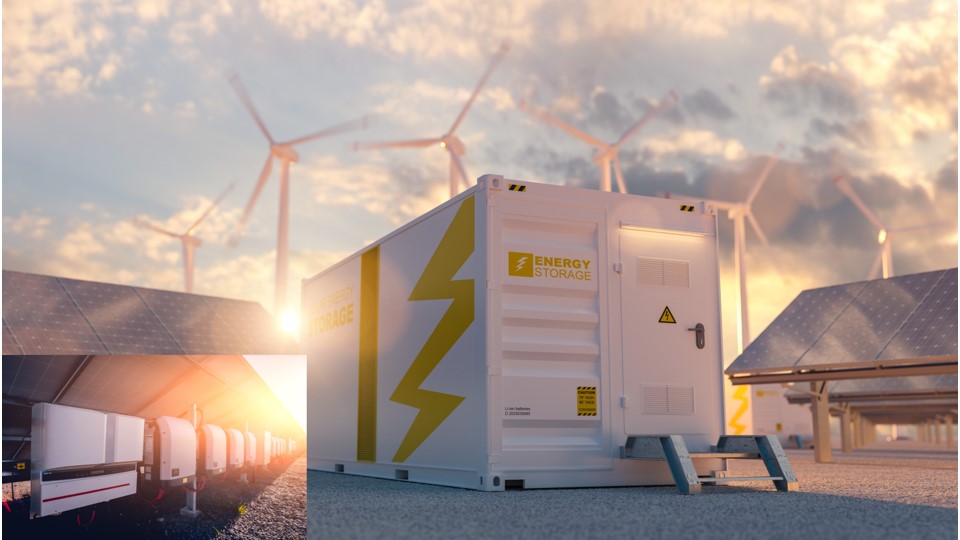

Grid-Forming Inverters: Their Impact on Stability, Resilience, and Integration
The unintended separation of the grid due to equipment failures, severe weather conditions, or human errors in the presence of grid-following inverters faces limitations. These inverters are designed to follow the grid’s voltage and frequency, rendering them unable to continue supplying power and maintaining stability without a connection to the main grid. This highlights the limitations of grid-following inverters in such situations. To overcome these challenges and ensure smooth integration of renewable energy sources and battery energy storage into electric grids, alternative control methods are necessary. GFI controls offer functionalities similar to synchronous machines and prove beneficial in addressing these concerns. Exhibit 1 provides a comparison between grid-following and grid-forming modes of inverters, while Exhibit 2 highlights various categories of GFIs that incorporate diverse strategies.
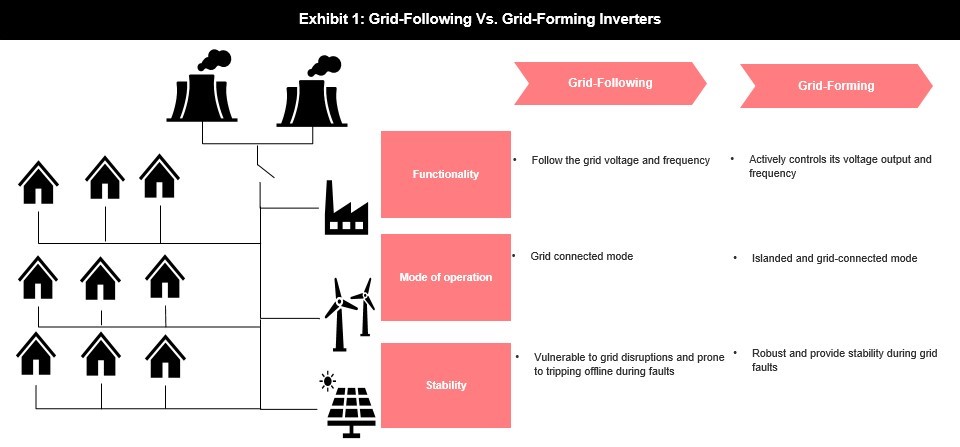

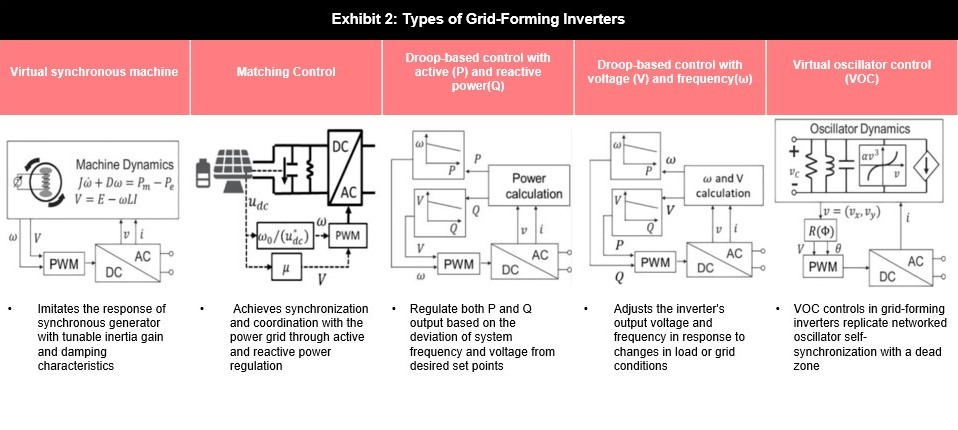
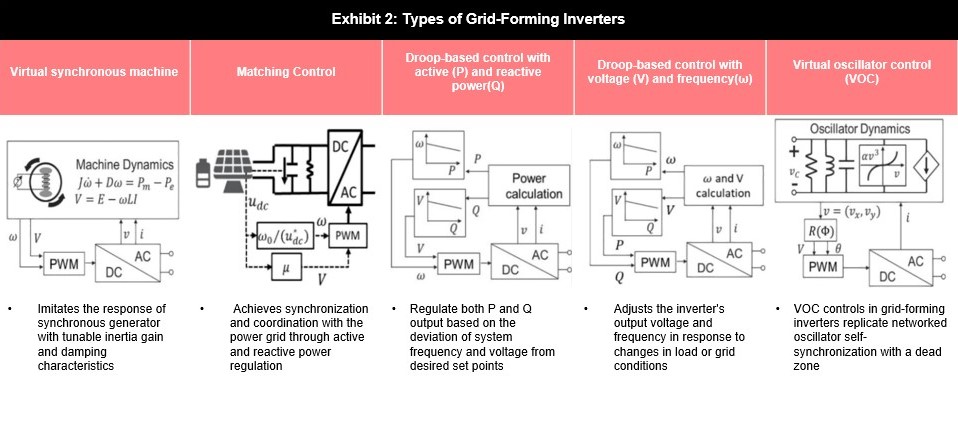
GFIs offer the advantage of standalone operation, reducing complexity and dependence on external systems. They can effectively function in both high-inertia and low-inertia grids, adapting to changing system conditions. These inverters can serve as independent black-start resources, restoring the grid from outages without relying on a strong grid connection. This enhances overall system reliability. Transmission Operators establish interconnection requirements for GFIs, following NERC FAC-001 guidelines. Collaboration between Transmission Providers and Planning Coordinators ensures the accurate representation of field equipment through appropriate models during the interconnection process. Interconnection requirements for GFIs prioritize performance over a specific control strategy.
Applications of Grid-Forming Inverters
GFIs are still undergoing active development and commercialization by research organizations and manufacturers. While there is no standardized control method for GFIs in the industry yet, successful installations of GFI projects in the field and simulations have been carried out. Additionally, various projects are currently being developed to integrate GFI technology into inverter-based resources. Here are some existing and upcoming projects that have utilized GFI technology:
- Hornsdale Power Reserve: This project demonstrated the effectiveness of its BESS Rate of Change of Frequency (ROCOF) function test, particularly the “virtual machine mode,” during grid disturbances caused by the Callide coal plant explosion in Queensland, Australia.
- California Imperial Irrigation District BESS: This project achieved synchronization of a 44 MW combined-cycle natural gas turbine synchronous generator, in a U.S. utility using GFIs.
- Sint Eustatius, NLD island: This project relies on solar energy for 46% of its electricity demand, made possible by GFIs that sustain the island grid for 10.5 hours in Diesel Off-Mode with over 100% Solar Power Fraction.
- Santa Rita Jail Microgrid: This microgrid utilizes approximately 1.5 MW of photovoltaic, a 1.0 MW fuel cell, and backup diesel generators. The power system relies on a 2 MW battery as the sole balancing resource, allowing the jail to operate either grid-connected or islanded.
- Hawaiian Electric Company: This company aims to deploy grid-forming inverter-based energy storage systems by 2023. Extensive work confirms the critical role of grid-forming inverter technology in ensuring reliable operations under high renewable energy penetration.
Global Experiences: Grid-Forming Functionality in Action
System operators in various countries are actively developing technical requirements for Grid-Forming Multi-Infeed capability which are mentioned below.
- Great Britain: National Grid Electricity System Operator (NGESO) has conducted studies on the performance of GFIs with a high share of inverter-based resources. As a result, NGESO has developed technical requirements for GFM (Grid Forming Multi) capability. This has led to the implementation of non-mandatory grid code change GC0137. NGESO launched the Great Britain Stability Pathfinder Programme that consists of three phases of tendering processes to procure synchronous and non-synchronous solutions for dynamic voltage support, short-circuit level, and inertia across different regions of the country. Compliance with grid code requirements, including GC0137, is expected in all phases of the program.
- Europe: ENTSO-E has led a coordinated effort among European stakeholders to define the capabilities of GFIs for Connection Network Codes (CNCs) ensuring standardized requirements across the EU. Market mechanisms will be used to procure grid-forming inverters functionalities, with qualification criteria outlined in CNCs for connecting Grid-Forming Multi-Infeed (GFM) Inverter-Based Resources (IBRs) to the grid.
- Australia: GFI-based battery energy storage systems are being installed in the Australian National Electricity Market, ranging from 30 MW to 500-600 MW. Pilot projects and market mechanisms are being utilized to test and compensate equipment owners for providing system services.
- Germany: Germany is developing requirements for GFM Converters through the VDE|FNN standard VDE-AR-N-4131 and its accompanying guideline. These documents specify technical standards including power imbalance management, ROCOF, inertia conditions, and voltage drop during grid faults.
These efforts reflect the global interest in harnessing the potential of GFI technology to enhance grid stability and accommodate high levels of intermittent renewable energy sources.
Stakeholders involved play a crucial role in advancing the development, deployment, and integration of GFIs. Power system operators benefit from GFI as they enhance grid stability, voltage control, and frequency regulation. Energy regulators ensure compliance with standards and grid codes for safe and efficient operation. Inverter manufacturers contribute by designing and supplying efficient GFIs. Renewable energy developers rely on these inverters to seamlessly integrate renewable energy sources into the grid. Research institutions drive innovation and technological advancements, while industry associations facilitate collaboration and advocacy. Through their collective efforts, stakeholders support the effective implementation and widespread adoption of GFI, enabling a more resilient and sustainable energy system.
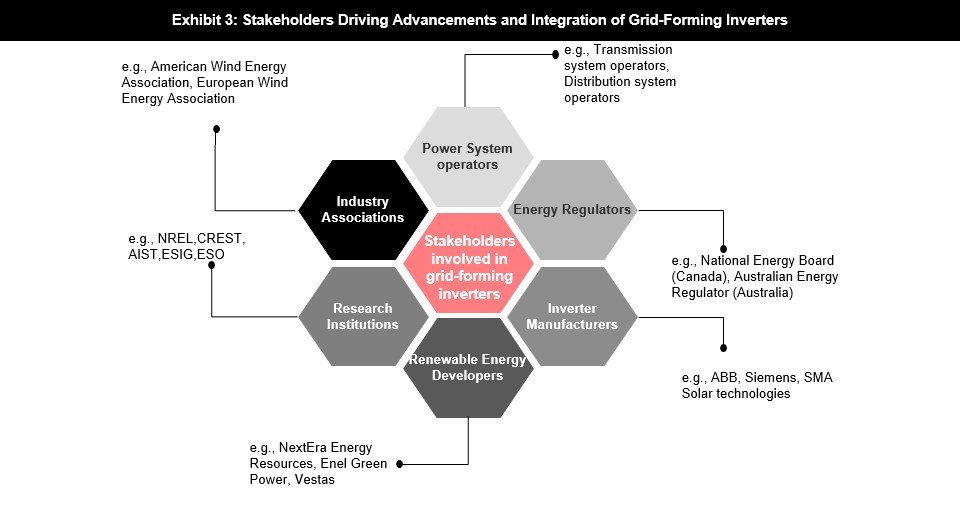

Market Outlook
- The global market for grid forming inverters is expected to witness robust growth rate, with a projected compound annual growth rate (CAGR) of around 10% during the forecast period of 2020-2025.
- The grid-forming inverters market is segmented by application, catering to residential, commercial, and utility sectors. This segmentation allows for targeted deployment of grid-forming inverters across diverse energy consumption domains.
- Numerous prominent companies and startups are driving advancements in GFI, leveraging their expertise and innovative technologies to enhance grid stability and accelerate the integration of renewable energy. Notable examples are displayed in Exhibit 4.
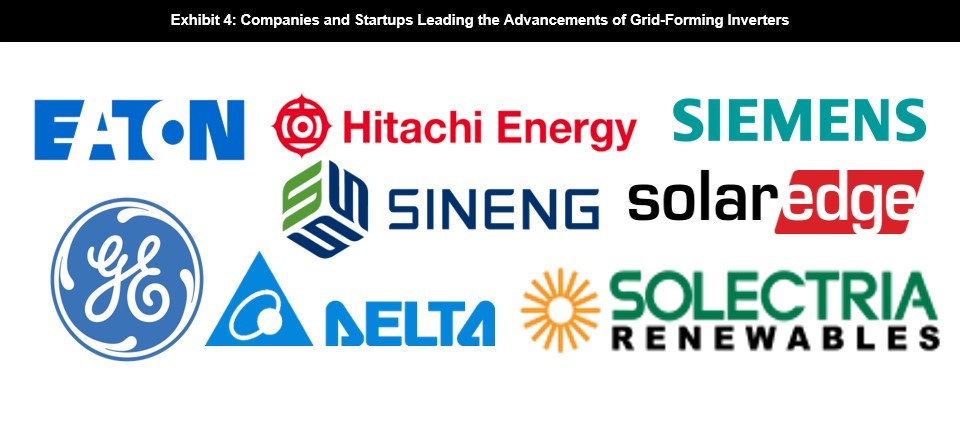

Challenges in deploying Grid-Forming Inverters
The deployment of advanced controls for IBRE faces a circular problem worldwide as illustrated in Exhibit-5. System operators and planners struggle to determine equipment capabilities and requirements for IBRE, resulting in operational constraints, curtailed output, and limited connectivity for IBREs. Manufacturers, lacking clear specifications and market incentives, are hesitant to invest in recent technologies. This cycle impedes the widespread deployment of advanced IBRE controls.
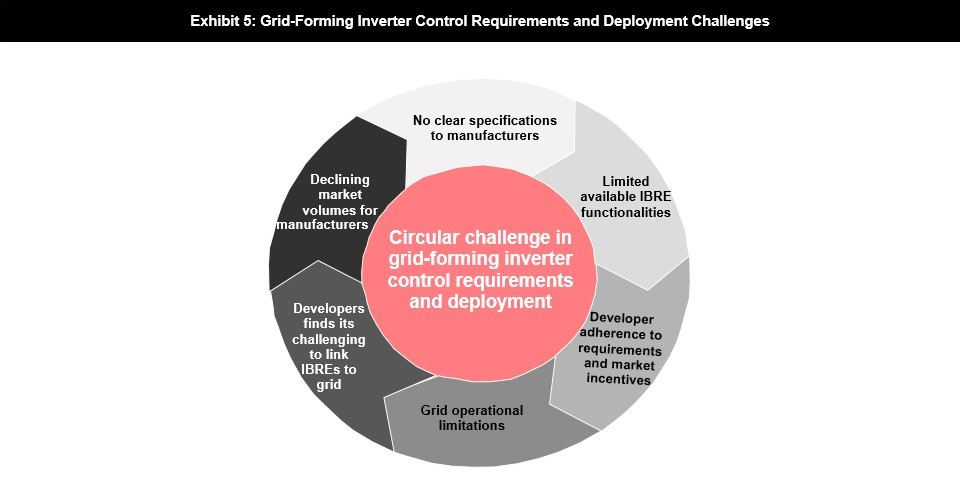

To break this cycle, collaboration between researchers, manufacturers, equipment owners, system operators, and policymakers is crucial in developing requirements, standards, technologies, and deployment mechanisms that reflect evolving grid reliability needs. Failure to do so may impede energy transition targets, increase transition costs, and hinder the achievement of a decarbonized future. Installing GFI technology resources can help avoid the need for larger grid-supporting devices or reinforcements in the future.
Why are big players interested in it?
- Market Demand: The global transition to renewable energy and the drive for decarbonization have generated an increasing market demand for GFIs, which are imperative for effectively integrating renewable resources. Manufacturers recognize the market’s growth potential and position themselves to meet the rising demand for GFIs.
- Competitive Edge: Incorporating GFIs into the inverters provides manufacturers with a distinct competitive advantage. By investing in the development and provision of GFI technologies that facilitate stable and efficient integration of renewable energy into the grid, manufacturers can set themselves apart from their competitors and capture a larger portion of the market.
- Long-Term Growth: With the increasing penetration of renewable energy and evolved grid architectures, GFI technology will play a crucial role in ensuring grid stability, facilitating energy storage integration, and enabling the transition to smart grids. Manufacturers recognize that grid-forming inverters are not just a short-term trend but rather a critical component of future energy systems.
Future Outlook
As the deployment of GFI continues to rise, their role on the grid is transforming. Currently, grid-following IBREs, which rely on strong grid signals for operation, dominate the market. However, the increasing number of IBREs poses limitations on the effectiveness of GFI controls. To ensure grid stability and drive an optimal future of power distribution, the adoption of advanced GFI controls becomes crucial.
GFIs offer voltage and frequency control, particularly in systems with full IBRE penetration. While GFI controls and their impact on bulk power system performance are still developing, the technology holds immense promise. Collaboration between system operators, manufacturers, and owners is essential to define system needs, comprehend equipment capabilities, and establish requirements for GFI technology adoption. Additionally, further research is necessary to assess stability and integrate various study processes. Embracing GFIs will pave the way for a future powered by clean and renewable energy sources.
Stay ahead in next-generation power distribution. Propel growth with inverter technology innovations. Discover new opportunities and business models. Get answers to your questions – speak to our experts today.
References
- Lin Y, Eto JH, Johnson BB, Flicker JD, Lasseter RH, Villegas Pico HN, Seo GS, Pierre BJ, Ellis A, “Research Roadmap on Grid-Forming Inverters”, NREL, Golden, CO (United States)
- “Grid Forming Technology Bulk Power System Reliability Considerations”, NERC
- Ellis A,” Grid Forming Inverters: Requirements and Practical Applications”, Sandia National Laboratories, Albuquerque, NM (United States)
- Matevosyan J, MacDowell J, Badrzadeh B, Cheng C, Dutta S, Rao SD, Gevorgian V, Green T, Howard D, Kong D,” Grid-Forming Technology in Energy Systems Integration”, ESIG High Share of Inverter-Based Generation Task Force: Report.
- “Grid-Forming Market Analysis-2023-2030”, Markwide Research
- “Grid-Forming Inverter Market: Global Opportunity Analysis and Industry Forecast, 2023-2032”, Allied Market Research
Need a thought partner?
Share your focus area or question to engage with our Analysts through the Business Objectives service.
Submit My Business ObjectiveOur Clients
Our long-standing clients include some of the worlds leading brands and forward-thinking corporations.
- © 2021 Cheers Interactive (India) Private Limited. All rights reserved. FutureBridge ® is a registered trademark of Cheers Interactive (India) Private Limited.































